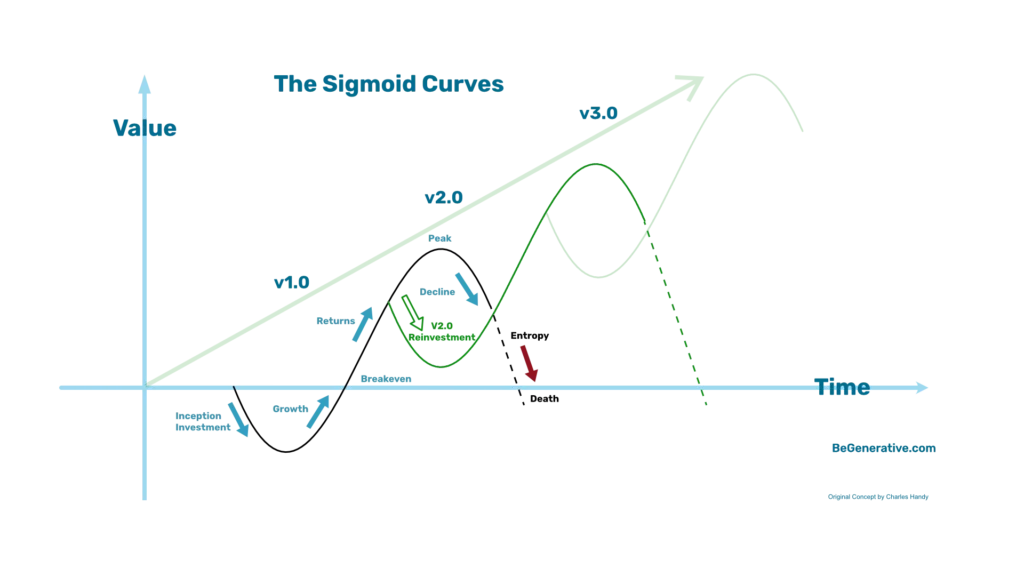
By Alan Froggatt
Everything grows, peaks, and declines.
Charles Handy called this natural pattern the Sigmoid Curve– an elegant model for understanding how systems, businesses, and even lives evolve over time.
The Shape of Growth
The curve begins with investment and struggle. Value starts below the line—costs exceed returns. Then comes the phase of growth, where effort compounds into visible progress. Eventually, success peaks. Energy plateaus. What once worked begins to fail.
Every product, organisation, or strategy follows this pattern. The curve shows that decline isn’t failure—it’s natural entropy. The problem is not the curve itself, but our blindness to it.
The Law of Renewal
The key insight Handy offered is simple but profound:
Renewal must begin while the first curve still rises.
If you wait until the decline is visible, it’s already too late.
This is where leaders falter. At the top of the curve, comfort, pride, and sunk costs obscure perception. The system becomes self-referential. Meetings focus on efficiency, not evolution. By the time performance falters, attention has turned reactive—patching, not pioneering.
The next curve—v2.0—demands a reinvestment before returns diminish. That requires courage, foresight, and what systems thinkers call meta-perception: the ability to see the structure beneath the event.
Seeing Through Systems
From a systems perspective, each Sigmoid Curve represents a feedback loop of energy, investment, and adaptation. The first loop optimises what exists; the second transforms what’s possible.
Peter Senge (1990) observed that “structure influences behaviour.” The curve is that structure. Without renewal, systems naturally reinforce the behaviours that once created success but now ensure stagnation.
To lead generatively is to work on the system, not just in it. It means recognising that every thriving organisation, career, or identity contains within it the seeds of its own decline—and that regeneration is an act of design, not accident.
Integral Renewal
From an Integral lens, each curve isn’t just a business cycle- it’s an evolution of consciousness.
The first curve solves practical problems (doing).
The second curve reframes purpose and meaning (being).
The third curve integrates these into systemic coherence (becoming).
At each turn, a broader worldview is required. Ken Wilber described development as the process by which what was once subject—what we were identified with—becomes object—something we can now work with consciously. Each curve demands this shift: what once defined success must now be transcended and included.
MetaIntegral Perspective: The Field of Curves
From a MetaIntegral perspective, no curve exists in isolation. Each sits within nested contexts—economic, cultural, ecological, and psychological. Renewal at one level often disrupts stability at another.
This is why organisational transformation can feel chaotic: the system reconfigures itself to host a new coherence.
Charles Handy’s wisdom prefigured this understanding. He wrote that “the second curve must start before the first begins to decline.” In other words, the next stage of value must be generated within the current structure, not after it collapses.
Practising Renewal
For leaders, the discipline is to create the conditions for curve two while curve one still thrives.
This means:
- Investing in innovation before it’s demanded
- Developing people faster than processes
- Allocating time for reflection amidst performance
- Building the capacity to hold paradox—short-term performance and long-term regeneration
The Human Curve
The Sigmoid isn’t only about business. It mirrors human development.
We grow, succeed, plateau, and—unless renewed—decline.
The generative act is to see our own curve as a cycle of becoming. Renewal is not just reinvention; it’s re-alignment with purpose.
The Call to Leaders
The BeGenerative model illustrates successive curves—v1.0, v2.0, v3.0—each beginning before the prior declines. It’s a living pattern of evolution.
Leadership, in this light, is not about control. It’s about timing, awareness, and the willingness to author the next curve before necessity forces it.
Charles Handy gave us a map of renewal.
Systems theory gives us the mechanisms.
Integral theory gives us the consciousness to navigate them.
To lead well is to see the curve before others feel it—and to begin again, while there is still strength to climb.
References
- Handy, C. (1994). The Empty Raincoat: Making Sense of the Future. London: Hutchinson.
- Senge, P. (1990). The Fifth Discipline: The Art and Practice of the Learning Organization. Doubleday.
- Wilber, K. (2000). Integral Psychology: Consciousness, Spirit, Psychology, Therapy. Shambhala.
https://begenerative.com/the-sigmoid-curve-in-practice-a-visual-narrative-for-leadership-teams